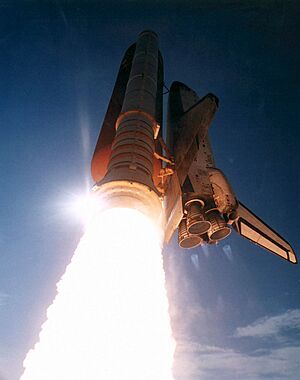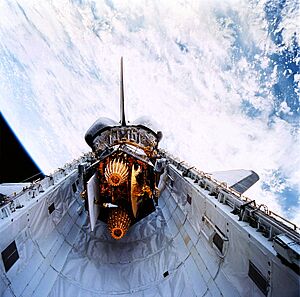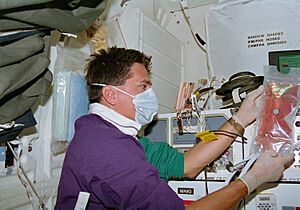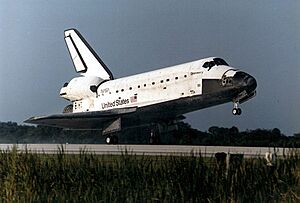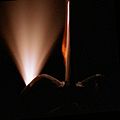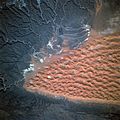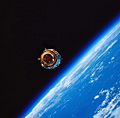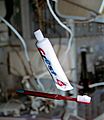STS-70 facts for kids
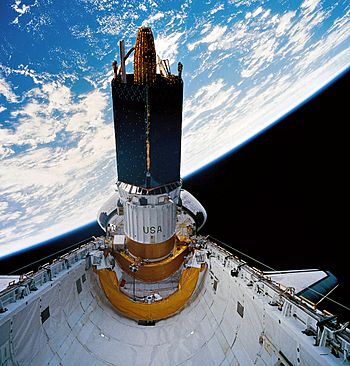
Discovery prepares to deploy the TDRS-G satellite
|
|
| Mission type | Satellite deployment |
|---|---|
| Operator | NASA |
| Mission duration | 8 days, 22 hours, 20 minutes, 05 seconds |
| Distance travelled | 6,000,000 kilometres (3,700,000 mi) |
| Orbits completed | 143 |
| Spacecraft properties | |
| Spacecraft | Space Shuttle Discovery |
| Payload mass | 20,159 kilograms (44,443 lb) |
| Crew | |
| Crew size | 5 |
| Members |
|
| Start of mission | |
| Launch date | 13 July 1995, 13:41:55.078 UTC |
| Launch site | Kennedy LC-39B |
| End of mission | |
| Landing date | 22 July 1995, 12:02 UTC |
| Landing site | Kennedy SLF Runway 33 |
| Orbital parameters | |
| Reference system | Geocentric |
| Regime | Low Earth |
| Perigee | 257 kilometres (160 mi) |
| Apogee | 257 kilometres (160 mi) |
| Inclination | 28.45 degrees |
| Period | 90.5 min |
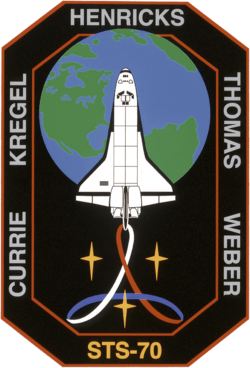 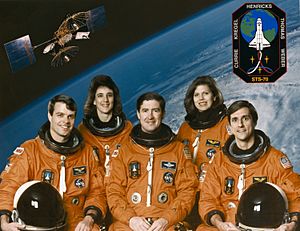 Left to right: Kregel, Currie, Henricks; Weber, Thomas |
|
STS-70 was the 21st flight of the Space Shuttle Discovery. This mission was the last of seven shuttle flights to carry a Tracking and Data Relay Satellite (TDRS) into space. It was also the first shuttle mission controlled from a new room at the mission control center in Houston. STS-70 was special because it used a new type of main engine, called the Block 1 orbiter main engine, which was designed to work better and be safer. The mission launched from Kennedy Space Center in Florida on July 13, 1995. This launch happened only six days after another shuttle, Atlantis, landed. This was the fastest time between two shuttle flights in the program's history!
Contents
Meet the Crew
| Position | Astronaut | |
|---|---|---|
| Commander | Terence T. Henricks Third spaceflight |
|
| Pilot | Kevin R. Kregel First spaceflight |
|
| Mission Specialist 1 | Donald A. Thomas Second spaceflight |
|
| Mission Specialist 2 | Nancy J. S. Currie Second spaceflight |
|
| Mission Specialist 3 | Mary E. Weber First spaceflight |
|
Getting Ready for Launch
The STS-70 mission was originally planned to launch before another mission, STS-71. However, there was a delay. On May 31, 1995, engineers found damage to the shuttle's External Tank. This damage was caused by woodpeckers! They had pecked about 71 holes in the tank's special foam insulation.
To fix this, technicians added special protections to stop more damage. On June 2, NASA decided to delay Discovery's launch to repair the insulation. Because of this, STS-71 launched first. Discovery was moved back to the Vehicle Assembly Building (VAB) on June 8. It was then returned to the launch pad on June 15.
Launch Day
The launch happened on July 13, 1995, at 9:41:55 a.m. EDT. The launch was held for 55 seconds just before liftoff. This was because of small changes seen in a safety system on the external tank. After checking everything, the launch continued as planned.
STS-70 was the first flight to use the new Block 1 orbiter main engine. This engine had new parts to make it more powerful and reliable. It was placed in the number one position on Discovery. The other two engines were older models.
Mission in Space
The main goal of the mission was to launch the 7th Tracking and Data Relay Satellite (TDRS-G). This satellite helps NASA communicate with other spacecraft. It was launched using a special two-stage rocket called the Inertial Upper Stage (IUS). The satellite weighed about 2,200 kilograms (4,850 pounds).
The TDRS-G satellite was released from Discovery's cargo bay exactly on time, about six hours into the flight. Mission Specialists Don Thomas and Mary Ellen Weber oversaw the release. About 15 minutes later, Commander Tom Henricks fired the shuttle's engines. This moved Discovery away from the satellite and the IUS.
About an hour after release, the IUS fired its engines. This pushed TDRS-G into its correct orbit. This orbit is called a geostationary orbit. It's about 35,000 kilometers (22,000 miles) high, above the central Pacific Ocean. Once fully unfolded, the satellite was about 17 meters (57 feet) wide.
Different control centers worked together for the satellite's deployment:
- The White Sands ground station controlled the TDRS satellite.
- The Johnson Space Center (JSC) Mission Control Center controlled the shuttle.
- The IUS control center at Onizuka Air Force Base controlled the booster rocket.
This TDRS was the sixth one to be used in space. These satellites are very important for NASA's communication network.
Other Experiments on Board
Besides deploying the satellite, the astronauts also did many other experiments. These included:
- PARE/NIH-R: Studying how rodents (like mice) are affected by space.
- Bioreactor Demonstration System (BDS): This experiment looked at how to grow cells into tissues in space. It used a special device that spins to make cells float. This helps scientists understand how tissues grow in microgravity.
- Commercial Protein Crystal Growth (CPCG): Growing protein crystals, which helps in making new medicines.
- Shuttle Amateur Radio Experiment-II (SAREX-II): Allowing astronauts to talk to amateur radio operators on Earth.
- HERCULES: A system to help astronauts find and target locations on Earth from space.
- Radiation Monitoring Equipment-III (RME-III): Measuring radiation levels inside the shuttle.
A special patch from the famous Coney Island Polar Bear Club was also carried on this mission!
Coming Home
Discovery was supposed to land at the Kennedy Space Center on July 21, 1995. However, thick fog covered the landing strip. Because of the poor visibility, the landing was delayed for a day. Astronaut Steve Oswald, who was flying a weather plane, reported that he couldn't see the runway.
STS-70 finally landed at the Kennedy Space Center on July 22, 1995, at 8:02 a.m. EDT. It touched down on Runway 33. The nose gear touched down at 8:02:11 a.m. EDT, and the wheels came to a complete stop at 8:02:57 a.m.
Images for kids
-
Space Shuttle Discovery STS-70 Launch. Taken with one of the first digital cameras: a Nikon E2.


